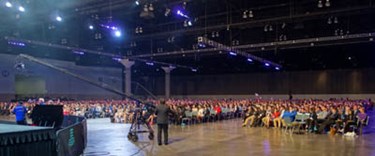Science Fairs Fan Photonics Interest, With Backing From SPIE

Students at all levels learn through competitions supported by SPIE funding, volunteers
Students from around the world enjoyed the excitement of competing for recognition in their scientific expertise at the Intel International Science and Engineering Fair (ISEF) in Los Angeles, California, last month. Top projects in various areas were awarded prizes sponsored by SPIE, the international society for optics and photonics, and other organizations.
ISEF is the world's largest pre-college science competition, providing an annual forum for more than 1,700 high school students from over 70 countries, regions, and territories competing for more than $5 million in awards from ISEF and organizations including SPIE.
ISEF is one of approximately 20 large- and small-scale science fairs and numerous similar demonstrations and competitions for students supported by SPIE outreach grants and other funding every year. In 2013, SPIE provided more than $3.2M in support of education and outreach programs.
Winners of SPIE-sponsored prizes at ISEF in Los Angeles came from around the world.
The first-place award, including a $2,500 prize, went to Ann Stasia Makosinski of Saint Michaels University School in Victoria, Canada, for "The Hollow Flashlights: Head and Hand."
Second-place and $1,500 went to Hadaia Azad Ezzulddin of the Nilufer Girls Secondary School in Erbil, Iraq, for "Infrared against Piracy."
Third-place and $1,000 went to Valerie Ding of Catlin Gabel School in Portland, Oregon, USA, for "Novel Automated Next-Generation Multijunction Quantum Dot Solar Panel Designs Using Monte Carlo-Based Modeling."
Three Honorable Mention awards were presented, to:
Yue Yao, High School Affiliated to Shanghai Jiao Tong University, JiaDing Campus, Shanghai, China, for "A New Optical Computing Method with Combination of Colored Lights Realizing Balanced Ternary Computation"
Christopher Shen, Texas Academy of Mathematics and Science, Denton, Texas, USA, for "Principles of Electrowetting on Liquid Prism Beam-Steering Module"
Achal James Fernando-Peiris, Mount Vernon High School, Mount Vernon, Ohio, USA, for "Fabricating an Artificial Nose using Mesoporous Photonic Crystals."
Volunteer judges for SPIE awards were John Tamkin, Imaging Insights;Virendra Mahajan, Aerospace Corp.; Tom Walker, Synopsys; Shouhua Huang, Jet Propulsion Lab; and Pramod Butte, Cedars-Sinai Medical Center.
Among other recent science events supported by SPIE:
Whitman-Hanson Regional High School (Massachusetts, USA) participated in a family science fun night where our advanced-placement students give lab demonstrations for grades kindergarten through 5.
Imperial College students presented an "Optics in Action" exhibition at the Big Bang London (UK) 2013 Science and Engineering Fair for ages 9 through 19, using interactive experiments to demonstrate basic optical principles.
The OSA and SPIE Student Chapter at University of California, Irvine, USA, along with partners Optics Institute of Southern California and the Optical Society of Southern California, demonstrated optical principles for hundreds of visitors at their booth on EXPO Day during the San Diego (California) Festival of Science & Engineering.
At the Cambridge (Massachusetts, USA) Science Festival, with financial support from SPIE the New England Section of the OSA presented optical demonstrations to 15,000 festival-goers at science carnival and the Massachusetts Institute of Technology (MIT) Student Chapter of the OSA presented to several hundred more inside the MIT Museum. The groups demonstrated holograms, FM radio, no-glasses-needed 3DTV, low-cost microscopy, and other photonics-based devices and phenomena.
Looking ahead, projects recently funded in the first of two annual rounds of outreach grant awards by SPIE will reach students from kindergarten through high school and beyond. Examples include:
The SPIE Student Chapter at the Indian Institute of Technology in Madras will set up displays at several schools and provide vision exams for students -- and even low-cost eyeglasses for qualifying students.
The University of the West Indies Mona will host the Jamaica Youth Science Forum, a science camp for students in grades 12 and 13, in conjunction with the Ministry of Education. In addition to lectures and optics experiments on topics such as polarization and diffraction, the forum will engage participants in a final project at the end.
A project at the Pratt Institute of Art and Design in New York City (USA) will demonstrate the origins and beauty of rainbows and reflections using two large-scale string sculptures. The sculptures will be built by students in a Science of Light class as part of a team prize competition and displayed at the 20,000-person, family-oriented Figment festival and on the Pratt Institute campus.
About SPIE
SPIE is the international society for optics and photonics, a not-for-profit organization founded in 1955 to advance light-based technologies. The Society serves nearly 256,000 constituents from approximately 155 countries, offering conferences, continuing education, books, journals, and a digital library in support of interdisciplinary information exchange, professional networking, and patent precedent. SPIE provided more than $3.2M in support of education and outreach programs in 2013.
Source: SPIE
